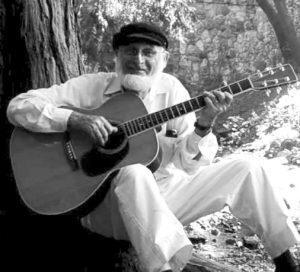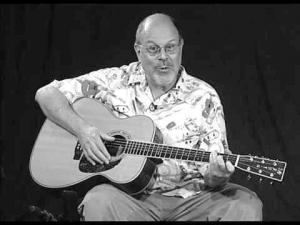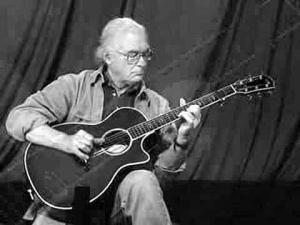
Ragtime guitar, both classic and barrelhouse styles, has been around exactly as long as ragtime piano for exactly the same reasons. Entertainers in bars, sporting houses, and private parties, whatever instrument they played, had to play whatever was currently popular. During the early part of the twentieth century it was ragtime music.
We’ve all seen photos and illustrations of (usually young) men or women playing what are now known as parlor (read small) guitars for audiences of friends in their homes. Again their repertoires would have included classic rags.
Those small instruments were the standard size of the time. The larger classical guitar that is now standard came later. My late wife’s parlor guitar that we traded for in 1967 was made in 1900. It is now being played by my granddaughter and still sounds great. You may think that classic piano rags would be very difficult to play on guitar, and, oh boy, do I agree. But then so is classical guitar which goes back another hundred years and was also part of the parlor concert repertoire.
So now let’s get to the revival that began among folk music fans in the fifties and sixties when Max Morath was repopularizing ragtime piano. At that time some of the great players of barrelhouse ragtime guitar were still alive and could be heard at folk festivals and in concerts.
Fans of the music could easily find the 78 RPM recordings of those that were gone. Some of those players were Pink Anderson, Blind Blake, Willie McTell, and Luke Jordan. Leadbelly, who was known as a blues man and as the composer of “Irene Goodnight,” a waltz, also played barrelhouse ragtime guitar and piano. You can easily find a recording of him playing and singing “Ella Speed,” a jumping ragtime tune. Reverend Gary Davis, Elisabeth Cotton, and Mississippi John Hurt are a few more of the great guitar players who were performing during the “folk boom” as it was called.
In the middle fifties the New Lost City Ramblers, an old time country music revival band led by Mike Seeger, Pete’s younger brother, recorded “Dallas Rag.” It was originally recorded by the Dallas String Band, an African American band that worked in the twenties and thirties.
Sometime in the late fifties an Antioch College student named Dave Laibman worked out a guitar arrangement of the song. Dave was originally from Cincinnati but settled in New York. I worked out my own arrangement of the tune at that time, but his was much better. As a matter of fact it was so good that it sparked the attempt by many other guitar players to develop their own solo arrangements of classic and barrelhouse rags.
Stefan Grossman, another wonderful guitar player as well as a guitar teacher and an entrepreneur, published a book of arrangements under the title of Fingerpicking Styles For Guitar that included Laibman’s arrangement of “Dallas Rag.” He also put out a compilation recording of classic and barrelhouse ragtime guitar players on his Kicking Mule label under the title of Contemporary Ragtime Guitar. The book and the record made ragtime guitar available to everyone, and the stampede was on.

At the same time, the early sixties, there was a revival of jug band music that included ragtime tunes. Some of the best known bands were Jim Kweskin’s Jug Band, recorded on Vanguard and Reprise, The Even Dozen Jug Band, recorded on Elektra, and Dave van Ronk’s Jug Band, recorded on Mercury. The San Francisco Area band, The Cleanliness and Godliness Skiffle Band recorded on Vanguard. My own Great Metropolitan Steam Band recorded in the later sixties for Decca.
Josh Rifkin, best known as a baroque piano player, had been a member of the Even Dozen Band. He helped spark the revival of interest in Scott Joplin’s music when he recorded an album of Joplin tunes on the Nonesuch Label. Going back to the early sixties, Dave van Ronk, best known as a blues man, worked out solo guitar arrangements of the classic rags “Temptation Rag” and “Saint Louis Tickle” and recorded them on his solo records as well as in band arrangements on his jug band record.
Meanwhile Dave Laibman had turned his hand to working out guitar arrangements of classic rags. His first recording, The New Ragtime Guitar, recorded with his cousin, Eric Schoenberg, came out in ’71 on the Folkways label. Since then it has never stopped. Recordings of classic rags on guitar are legion. In addition to those mentioned already, the names of some of the players are Duck Baker, Dale Miller, and Jorma Kekonan, best known as a member of the Jefferson Airplane rock band. One of the best of the current crop of ragtime guitar players is Craig Ventresco of San Francisco. He plays classic rags and plays and sings barrelhouse rags and novelty tunes in a wonderfully entertaining manner.
In the early seventies I had a ragtime radio show on the MIT station in Cambridge, Mass. together with my producer/engineer, Dave Palmetier. The show was called The Great Ragtime in the Sky. We played recordings of all manner of classic and barrelhouse rags.
At that time Gunther Schuler, the director of the New England Conservatory, organized the New England Conservatory Ragtime Ensemble to play from the newly rediscovered book of Scott Joplin’s orchestrations of his own rags. It was originally published under the name of Fifteen High Class Rags and was known as the Red Back Book. Dave Palmetier recorded the first public performance of the work, and we put it on the air. Marvin Hamlish’s orchestration of Joplin’s “The Entertainer,” popularized by the movie, The Sting, sounds very much like the kind of arrangements Joplin did.
One sad note: of all of the top ragtime guitar players you can hear live, you won’t get to hear Dave Laibman who is absolutely the best of all of us and refuses to perform. You can find his recordings and some of his work on Facebook or YouTube, but that’s all.

When I called him many years ago and asked if he wanted to work at one or another ragtime festival, he said, “Hell no. This stuff’s too hard to play.” He makes his living as a professor of economics at Brooklyn College and continues to compose and play, but only for himself and his friends. Ah well.
Hard to play it is. I studied classical guitar for several years and gave it up because I wasn’t good enough. Now I struggle with classic ragtime pieces that are just as hard, but it’s worth it. I’ll tell you a story about that. At an open mic I played at years ago, one of the performers was a classical guitarist, a very friendly, warm fellow. I included a classic rag in my short set. Later on he came back on stage and said, “Oh yeah. Ragtime guitar. I used to do that.” Then he played a classic rag better than I could have. So be it. I still love ragtime guitar, both classic and barrelhouse styles, and continue to enjoy performing and teaching it.
Guitarist Eliot Kenin is the longtime leader of the bands Spirit of ’29 and Reinhardt Swing. Write him at eliotkenin@yahoo.com.






















